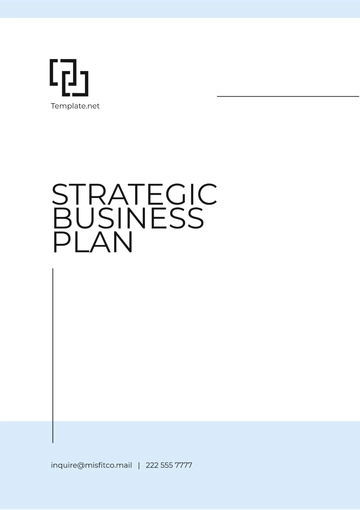Free Business Rescue Plan

I. Executive Summary
The Executive Summary encapsulates the essence of the Business Rescue Plan, highlighting the objectives, strategies, and key initiatives required to revive the financially troubled business. It provides a concise overview for stakeholders, emphasizing the importance of this strategic document in guiding the rehabilitation process and ensuring the long-term viability of the business.
II. Business Overview
Introduction
EcoTech Innovations Inc. is a leading provider of sustainable energy solutions, specializing in solar power systems and energy-efficient technologies. Established in 2010, the company has faced financial challenges due to economic downturns and increased competition in the renewable energy sector.

Mission Statement
EcoTech Innovations Inc. is committed to pioneering innovative solutions that promote environmental sustainability and energy independence.
Vision Statement
To lead the transition to a clean energy future by delivering cutting-edge technologies and services that empower communities and businesses to thrive while preserving the planet for future generations.
III. Business Analysis
SWOT Analysis
Strengths:
Established brand reputation for quality and reliability
Extensive network of strategic partnerships with government agencies and industry stakeholders
Strong research and development capabilities driving technological innovation
Weaknesses:
Declining profitability due to pricing pressures and increased production costs
Heavy reliance on external financing to fund expansion initiatives
Limited geographic presence compared to competitors
Opportunities:
Growing demand for renewable energy solutions driven by increasing environmental awareness and government incentives
Technological advancements in solar panel efficiency and energy storage technologies
Expansion into emerging markets with untapped renewable energy potential
Threats:
Intense competition from large conglomerates and new entrants in the renewable energy sector
Fluctuations in government policies and regulations affecting renewable energy subsidies and incentives
Volatility in raw material prices and currency exchange rates impacting production costs
Financial Analysis
Historical Financial Performance: Despite steady revenue growth in recent years, the company has experienced a decline in profitability due to rising operational expenses and debt servicing costs.
Current Financial Position: The company's liquidity position remains stable, supported by a healthy cash reserve and access to credit facilities. However, increasing debt levels raise concerns about long-term solvency.
Cash Flow Analysis: Cash flow from operations has been positive but fluctuating, reflecting seasonal variations in project installations and payment cycles from clients.
Debt Analysis: The company's debt-to-equity ratio has exceeded industry benchmarks, indicating a high level of financial leverage and potential risk of default.
IV. Turnaround Strategies
Operational Restructuring
Streamline production processes and supply chain management to reduce lead times and improve cost efficiency.
Invest in employee training and development programs to enhance technical skills and productivity levels.
Optimize inventory management practices to minimize carrying costs and mitigate the risk of obsolete stock.
Financial Restructuring
Negotiate with creditors to restructure existing debt obligations, including extending repayment terms and reducing interest rates.
Explore alternative financing options such as asset-based lending or equity investment to strengthen the company's capital structure.
Implement stringent cost control measures to reduce discretionary spending and improve cash flow management.
Market Repositioning
Conduct market research to identify niche segments and untapped opportunities for product differentiation.
Enhance marketing and branding efforts to reinforce the company's value proposition and differentiate it from competitors.
Expand geographic footprint through strategic partnerships and joint ventures to access new markets and customer segments.
V. Implementation Plan
Timeline
Phase 1: Operational Assessment and Planning (January - February 2050)
Phase 2: Implementation of Turnaround Strategies (March - June 2050)
Phase 3: Monitoring and Evaluation (July 2050 onwards)
Resource Allocation
Human Resources: Assign cross-functional teams to oversee the implementation of turnaround strategies and monitor performance metrics.
Financial Resources: Allocate budgetary provisions for restructuring initiatives and working capital requirements.
Technology: Invest in advanced automation and digitalization tools to streamline operations and enhance efficiency.
Key Performance Indicators (KPIs)
Revenue growth rate: Target annual revenue growth of 15% by 2055.
Gross profit margin: Aim to increase gross margin by 5% through cost optimization measures.
Operating cash flow: Maintain positive operating cash flow to support ongoing business operations and capital investments.
Debt-to-equity ratio: Gradually reduce debt levels to achieve a sustainable capital structure by 2060.
Customer satisfaction index: Measure and improve customer satisfaction levels through enhanced service delivery and product quality.
VI. Risk Management
Identify potential risks and uncertainties that may impact the implementation of the rescue plan, such as regulatory changes, supply chain disruptions, and market volatility.
Develop contingency plans and mitigation strategies to address identified risks, including diversification of revenue streams and hedging against currency fluctuations.
Regularly monitor and assess risk exposure to ensure proactive management and timely response to emerging threats.
VII. Stakeholder Communication
Establish transparent communication channels with stakeholders, including employees, creditors, suppliers, and investors, to provide regular updates on the progress of the rescue plan and solicit feedback and input.
Host stakeholder engagement sessions and town hall meetings to foster collaboration and alignment of interests towards common objectives.
Cultivate trust and credibility through open and honest dialogue, demonstrating commitment to addressing concerns and delivering sustainable long-term value.
VIII. Conclusion
The Business Rescue Plan outlines a comprehensive framework for revitalizing the operations of EcoTech Innovations Inc. and restoring its financial health and competitiveness in the renewable energy sector. By implementing the proposed strategies and initiatives, we aim to overcome current challenges and capitalize on future opportunities, positioning the company for sustainable growth and success in the decades to come.
IX. Appendix
Additional financial projections for the next decade
Market research reports and industry analysis
Legal documents related to debt restructuring agreements
Organizational charts and key personnel profiles
- 100% Customizable, free editor
- Access 1 Million+ Templates, photo’s & graphics
- Download or share as a template
- Click and replace photos, graphics, text, backgrounds
- Resize, crop, AI write & more
- Access advanced editor
We are introducing the Business Rescue Plan Template from Template.net. Crafted for swift action in turbulent times, this editable and customizable resource empowers entrepreneurs with a structured blueprint for financial recovery. Tailor-made sections guide users through strategic planning, economic analysis, and risk mitigation. Effortlessly editable in our AI Editor Tool, it ensures adaptability for every business scenario.
You may also like
- One Page Business Plan
- Coffee Shop Business Plan
- Restaurant Business Plan
- Food Business Plan
- Real Estate Business Plan
- Executive Summary Business Plan
- Cover Page Business Plan
- Nonprofit Business Plan
- Daycare Business Plan
- Construction Business Plan
- Startup Business Plan
- Medical Business Plan
- Bakery Business Plan
- Service Plan
- Hotel Business Plan
- Catering Business Plan
- School Business Plan
- Healthcare Business Plan
- Transportation Plan
- Sports Plan
- Car Wash Business Plan
- Salon Business Plan
- Clothing Business Plan
- Farming Business Plan
- Boutique Plan





























